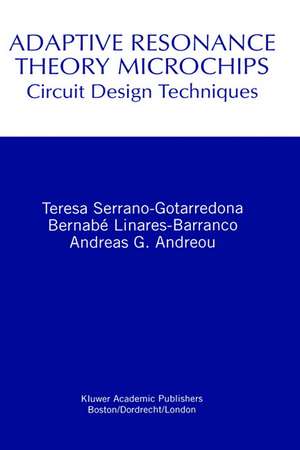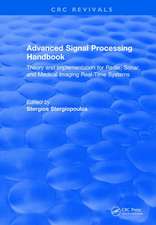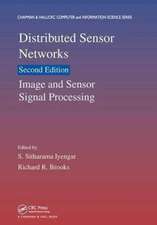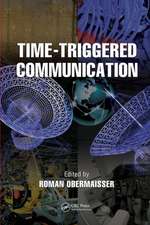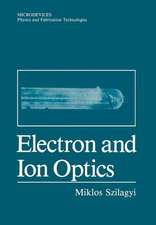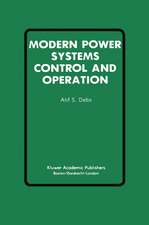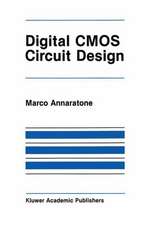Adaptive Resonance Theory Microchips: Circuit Design Techniques: The Springer International Series in Engineering and Computer Science, cartea 456
Autor Teresa Serrano-Gotarredona, Bernabé Linares-Barranco, Andreas G. Andreouen Limba Engleză Hardback – 31 aug 1998
| Toate formatele și edițiile | Preț | Express |
|---|---|---|
| Paperback (1) | 942.94 lei 6-8 săpt. | |
| Springer Us – 5 sep 2012 | 942.94 lei 6-8 săpt. | |
| Hardback (1) | 948.92 lei 6-8 săpt. | |
| Springer Us – 31 aug 1998 | 948.92 lei 6-8 săpt. |
Din seria The Springer International Series in Engineering and Computer Science
- 24%
 Preț: 1041.97 lei
Preț: 1041.97 lei - 20%
 Preț: 643.50 lei
Preț: 643.50 lei - 18%
 Preț: 1225.62 lei
Preț: 1225.62 lei - 18%
 Preț: 965.02 lei
Preț: 965.02 lei - 20%
 Preț: 646.12 lei
Preț: 646.12 lei - 18%
 Preț: 948.79 lei
Preț: 948.79 lei - 20%
 Preț: 646.62 lei
Preț: 646.62 lei - 15%
 Preț: 637.46 lei
Preț: 637.46 lei - 20%
 Preț: 643.83 lei
Preț: 643.83 lei - 18%
 Preț: 949.23 lei
Preț: 949.23 lei - 20%
 Preț: 644.48 lei
Preț: 644.48 lei - 20%
 Preț: 994.92 lei
Preț: 994.92 lei - 20%
 Preț: 645.97 lei
Preț: 645.97 lei - 18%
 Preț: 946.87 lei
Preț: 946.87 lei - 20%
 Preț: 995.57 lei
Preț: 995.57 lei - 18%
 Preț: 956.99 lei
Preț: 956.99 lei - 20%
 Preț: 644.98 lei
Preț: 644.98 lei - 15%
 Preț: 649.54 lei
Preț: 649.54 lei - 18%
 Preț: 950.21 lei
Preț: 950.21 lei - 18%
 Preț: 1221.38 lei
Preț: 1221.38 lei - 18%
 Preț: 957.62 lei
Preț: 957.62 lei - 15%
 Preț: 643.99 lei
Preț: 643.99 lei - 18%
 Preț: 948.47 lei
Preț: 948.47 lei - 18%
 Preț: 947.35 lei
Preț: 947.35 lei - 20%
 Preț: 1284.65 lei
Preț: 1284.65 lei - 20%
 Preț: 1628.31 lei
Preț: 1628.31 lei - 20%
 Preț: 1285.78 lei
Preț: 1285.78 lei
Preț: 948.92 lei
Preț vechi: 1157.22 lei
-18% Nou
Puncte Express: 1423
Preț estimativ în valută:
181.57€ • 190.09$ • 150.24£
181.57€ • 190.09$ • 150.24£
Carte tipărită la comandă
Livrare economică 05-19 aprilie
Preluare comenzi: 021 569.72.76
Specificații
ISBN-13: 9780792382317
ISBN-10: 0792382315
Pagini: 234
Ilustrații: XXIII, 234 p.
Dimensiuni: 155 x 235 x 16 mm
Greutate: 0.54 kg
Ediția:1998
Editura: Springer Us
Colecția Springer
Seria The Springer International Series in Engineering and Computer Science
Locul publicării:New York, NY, United States
ISBN-10: 0792382315
Pagini: 234
Ilustrații: XXIII, 234 p.
Dimensiuni: 155 x 235 x 16 mm
Greutate: 0.54 kg
Ediția:1998
Editura: Springer Us
Colecția Springer
Seria The Springer International Series in Engineering and Computer Science
Locul publicării:New York, NY, United States
Public țintă
ResearchCuprins
1. Adaptive Resonance Theory Algorithms.- 1.1 Introduction.- 1.2 ART1.- 1.3 ARTMAP.- 1.4 Fuzzy-ART.- 1.5 Fuzzy-ARTMAP.- 2. A Vlsi-Friendly ART1 Algorithm.- 2.1 The Modified ART1 Algorithm.- 2.2 Functional Differences between Original and Modified Model.- 3. ART1 And ARTMAP Vlsi Circuit Implementation.- 3.1 Introduction.- 3.2 Hardware-Oriented Attractive Properties of the ART1 Algorithm.- 3.3 Circuit Description.- 3.4 Modular System Expansivity.- 3.5 Implementation of Synaptic Current Sources.- 3.6 Experimental Results of First Prototype.- 3.7 Experimental Results of Second Prototype.- 4. A Current-Mode Multi-Chip WTA-MAX Circuit.- 4.1 Introduction.- 4.2 Operation Principle.- 4.3 Circuit Implementation.- 4.4 System Stability Coarse Analysis.- 4.5 System Stability Fine Analysis.- 4.6 Experimental Results.- 5. An ART1/ARTMAP/Fuzzy-ART/Fuzzy-ARTMAP Chip.- 5.1 The Synaptic Cell.- 5.2 Peripheral Cells.- 5.3 Concluding Remarks.- 6. Analog Learning Fuzzy Art Chips.- 6.1 Introduction.- 6.2 Summary of the Fuzzy-ART Algorithm.- 6.3 Current-Mode Fuzzy-ART Chip.- 6.4 Fuzzy-ART/VQ Chip.- 6.5 Conclusions.- 7. Some Potential Applications For Art Microchips.- 7.1 Portable Non-invasive Device for Determination of Concentrations of Biological Substances.- 7.2 Cardiac Arrhythmia Classifier for Implantable Pacemaker.- 7.3 Vehicle Interior Monitoring Device for Auto Alarm.- 7.4 Concluding Remarks.- Appendices.- A- MATLAB Codes for Adaptive Resonance Theory Algorithms.- A.1 MATLAB Code Example for ART1.- A.2 MATLAB Code Example for ARTMAP.- A.3 MATLAB Code Example for Fuzzy-ART.- A.4 MATLAB Code Example for Fuzzy-ARTMAP.- A. 5 Auxiliary Functions.- B- Computational Equivalence of the Original ART1 and the Modified ART1m Models.- B. l Direct Access to Subset and Superset Patterns.- B. 2 DirectAccess by Perfectly Learned Patterns (Theorem 1 of original ART1).- B. 3 Stable Choices in STM (Theorem 2 of original ART1).- B. 4 Initial Filter Values determine Search Order (Theorem 3 of original ART1).- B. 5 Learning on a Single Trial (Theorem 4 of original ART1.- B. 6 Stable Category Learning (Theorem 5 of original ART1.- B. 7 Direct Access after Learning Self-Stabilizes (Theorem 6 of original ART1).- B.8 Search Order(Theorem 7 of original ART1).- B.9 Biasing the Network towards Uncommitted Nodes.- B.10 Expanding Proofs to Fuzzy-ART.- B. 11 Remarks.- C- Systematic Width-and-Length Dependent CMOS Transistor Mismatch Characterization.- C.1 Mismatch Characterization Chip.- C.2 Mismatch Parameter Extraction and Statistical Characterization.- C.3 Characterization Results.- References.
